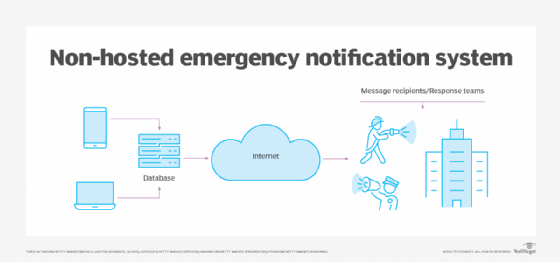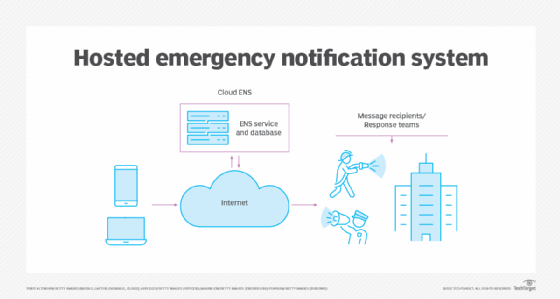What is an emergency notification system?
An emergency notification system is an automated approach to crisis communications that contacts people within an organization and distributes important information during a disruption.
Following an outage or other disruptive event, an organization must determine the severity and potential impact of the incident, and then communicate with employees, management and other key stakeholders.
Emergency notification systems relay corporate communications in real time, through phone messages, texts and emails.
How does an emergency notification system work?
An emergency notification system contains a database of names, addresses, phone numbers, email addresses and social media contacts. When activated, the system can send thousands of messages within minutes. It can also receive and process incoming messages from recipients about their status.
Systems can be in-house (non-hosted) or managed services (hosted). Traditional emergency notification functions took place on-site, with a database connected to the internet or telephone company to send out messages.

With a hosted system, users access those resources through a phone or the internet, launch the notification process, and remotely manage successive activities. Some vendors have started to incorporate artificial intelligence and machine learning into emergency notification systems.
Organizations of any size can implement an emergency communications plan. It is especially vital if there are multiple office locations to coordinate between or many employees and stakeholders to contact. Organizations that could affect nearby communities, such as those that deal with hazardous materials, must have these lines of communication in place to reach employees and local residents.

Implementing an emergency notification system
When planning an emergency notification system, organizations must do the following:
- Analyze anticipated requirements and determine if the number of employees is sufficient to justify the investment.
- Check if existing technology features can be used in the system.
- Confirm that the network infrastructure has sufficient bandwidth to handle such a system during an emergency.
- Allow enough time to develop the database and conduct user training.
- Determine how to integrate the system into a business continuity and disaster recovery plan.
It is crucial to keep emergency notification systems up to date. Systems that use a combination of voice, text and email notifications are more likely to be successful than single notification methods, as it's unlikely that an employee would change all their contact information at once. In addition, a cellphone network could go down during a disaster, while an email system could still be functional.
The entire system should also be tested on a regular basis -- for example, using calls and message blasts.
While a call tree might have been a viable option in the past, it is no longer sustainable. A call tree is time-consuming, and if one person cannot be reached, the process can break down. It can still be used as a supplement to the notification system.
Pricing and vendors
Prices for a standalone emergency notification system can cost up to hundreds of thousands of dollars. Managed offerings are available for a monthly fee that is typically based on the number of contacts, features in use and network services needed. There might also be setup fees when the database is built, as well as activation fees when the system is used in a disaster. Monthly fees can run more than $25,000.
Vendors include AlertMedia, Alertus Technologies, Everbridge, F24, InformaCast Mobile, OnSolve, Rave Mobile Safety, Red Flag Alert, SwiftReach and Visiplex.








